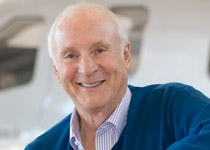 1. Within three years of its introduction, this particular type of airliner was carrying 95 percent of all airline passengers in the United States. What type of aircraft was this?
1. Within three years of its introduction, this particular type of airliner was carrying 95 percent of all airline passengers in the United States. What type of aircraft was this?
2. What was the world’s first aviation regulation?
3. From reader John Schmidt: Prior to beginning his political career, what future U.S. president missed a scheduled flight—a fortuitous circumstance that saved his life, because that flight subsequently crashed?
4. A pilot opens the cockpit door, lowers the flaps, turns on the carburetor heat, retards the throttle fully, and turns off one magneto. Why is he doing these things?
5. Last March, Qantas Airways Flight QF9 flew the 9,009-sm (7,828-nm) nonstop flight from Perth, Australia, to London, England, in 17 hours 20 minutes using a Boeing 787-9 Dreamliner. But there have been longer flights. What U.S. airline, using what type of airplane, holds the current world record for the longest airline flight (timewise) in a landplane?
6. A pilot inadvertently fails to secure a manual, plunger-type primer after priming the engine prior to starting. What could be the likely result?
7. What is or was the world’s fastest single-engine jet airplane?
8. One of the most famous airplanes in the world is the Piper J–3 Cub. What does the J represent?
Test Pilot Answers
1. American Airlines inaugurated passenger service with the Douglas DC–3 on June 26, 1936. Production of the DC–3 ended in 1942 after 607 had been built. However, more than 16,000 were built when including the C–47, military version of the DC–3.
2. The French instituted a regulation prohibiting the Montgolfier brothers from flying a hot-air balloon on Sundays.
3. After boarding the Martin B–26 Marauder on June 9, 1942, Lyndon Johnson deplaned because of his need to visit a restroom. The Wabash Cannonball was subsequently shot down, killing all aboard, including his roommate at the time.
4. He is taxiing a seaplane into the wind and toward a docking, beaching, or mooring area and needs to reduce taxi speed as much as possible by increasing drag and decreasing idle thrust. (Seaplanes obviously do not have brakes.)
5. On October 1 and 2, 1957, TWA Flight 801, a Lockheed 1649A Constellation, needed 23 hours and 19 minutes to fly from London to San Francisco.
6. If the plunger works its way out to the open position during flight, fuel will be drawn through the primer and into the engine. This can result in such an excessively rich mixture that the engine will lose power or fail entirely. Always verify that the plunger is locked in the closed position before takeoff.
7. A modified Convair F–106 Delta Dart holds a world speed record of 1,526 mph (Mach 2.31) set on December 15, 1959. The Soviets claimed that their prototype YE–152-1, a version of the MiG–21, was clocked at 1,666 mph a few years later, but this has never been verified.
8. The J stood for Walter C. Jamouneau, William Piper’s chief engineer during the development of the J–2 and J–3 Cubs.



